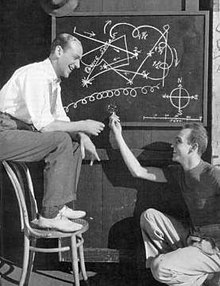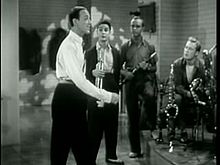| Revision as of 13:02, 22 September 2008 editTaBOT-zerem (talk | contribs)28,640 editsm robot Adding: fr:Hermes Pan← Previous edit | Revision as of 13:43, 29 October 2008 edit undoGirisha-jin (talk | contribs)112 editsmNo edit summaryNext edit → | ||
| Line 4: | Line 4: | ||
| ==Early life== | ==Early life== | ||
| Pan was born '''Hermes |
Pan was born '''Hermes Panagiotopoulos''' in 1910 in ], of ] and ] extraction. His father was from ] in ] where his family had opened the first theatre; he was sent to Memphis as the Greek consul - never to return to Greece. Following the death of his father, his uncle held them at gun point and burnt all their shares and money on the grounds that if he could not have them, no one would. Hermes and his sister Vasso were eventually raised ] by his mother, the former Mary Huston. They moved penniless to the poorest area of New York were Hermes learnt his first tap dancing steps on the streets from the local black kids. At their lowest ebb, the family had only some potatoes and coffee for their meal; since that day they vowed to commemorate it and evey year, on the same day, shared the same frugal meal. Eventually, he headed with his sister West to LA. His career began with an appearance as a chorus boy in 1928 in the ] Broadway production of ''Animal Crackers'', and he also performed in a dance partnership with his sister Vasso, who subsequently appeared in the chorus of many of the Astaire-Rogers pictures. He first met ] in 1930, when he appeared as a chorus singer in the Broadway musical ''Top Speed.'' | ||
| ==Collaboration with Fred Astaire== | ==Collaboration with Fred Astaire== | ||
Revision as of 13:43, 29 October 2008

Hermes Pan (December 10, 1910 – September 19, 1990) was an American dancer and choreographer, principally celebrated as Fred Astaire's choreographic collaborator on the famous 1930s movie musicals starring Astaire and Ginger Rogers.
Early life
Pan was born Hermes Panagiotopoulos in 1910 in Nashville, Tennessee, of Greek and Irish extraction. His father was from Aigio in Peloponnese where his family had opened the first theatre; he was sent to Memphis as the Greek consul - never to return to Greece. Following the death of his father, his uncle held them at gun point and burnt all their shares and money on the grounds that if he could not have them, no one would. Hermes and his sister Vasso were eventually raised Catholic by his mother, the former Mary Huston. They moved penniless to the poorest area of New York were Hermes learnt his first tap dancing steps on the streets from the local black kids. At their lowest ebb, the family had only some potatoes and coffee for their meal; since that day they vowed to commemorate it and evey year, on the same day, shared the same frugal meal. Eventually, he headed with his sister West to LA. His career began with an appearance as a chorus boy in 1928 in the Marx Brothers Broadway production of Animal Crackers, and he also performed in a dance partnership with his sister Vasso, who subsequently appeared in the chorus of many of the Astaire-Rogers pictures. He first met Ginger Rogers in 1930, when he appeared as a chorus singer in the Broadway musical Top Speed.
Collaboration with Fred Astaire

He met Fred Astaire, whom he physically resembled, on the set of Flying Down to Rio (1933), in which he worked as an assistant to dance director Dave Gould. While Astaire was trying to work out a series of steps for "The Carioca" number, it was suggested to him that Pan had a few ideas and Pan was invited over. Hermes Pan demonstrated a brief break he had picked up from his street days in New York and from then on the two began a lifelong professional collaboration and friendship which included all the RKO Astaire pictures, including A Damsel in Distress (1937) in which Ginger Rogers did not appear, and for which he was awarded the 1937 Academy Award for Best Dance Direction. He had previously received Academy Award nominations for the "Top Hat" and "The Piccolino" numbers from Top Hat (1935) and for the "Bojangles of Harlem"' number from Swing Time (1936).
The Astaire-Pan collaboration, involving 17 out of Astaire's 31 musical films and three of his four television specials, is widely accepted as one of the most important forces in dance choreography of 20th century film and television musicals. Astaire called Pan his "ideas man", and while he generally choreographed his own routines, and sometimes worked with other choreographers, he greatly valued the assistance of Pan not just as a source and critic of ideas, but also as a rehearsal partner for the purposes of fine-tuning a routine.
Given Astaire's obsessive rehearsal habits, this was no mean task. Pan also performed the essential function of rehearsing Ginger Rogers, whose many other commitments during the filming of the Astaire-Rogers musicals often conflicted with Astaire's rehearsal schedule. In addition, he recorded Ginger's taps in post production.
For the spectacular staging of Cleopatra in 1963 starring Elizabeth Taylor, he asked what budget he should work to, he was told to just get on with it and not worry about the money. The result was one of the most spectacular sets in film history.
Pan continued to collaborate with Astaire right up until the latter's last musical picture, Finian's Rainbow (1968), which was a disaster on a number of fronts, not least for Pan himself. The young director Francis Ford Coppola had no prior experience with musical films, and proceeded to ride roughshod over Astaire and Pan's plans for the film's dance routines, reintroducing the style of dancing camera of the early 1930s which Astaire had done so much to banish from the Hollywood musical. Eventually, Coppola fired Pan, who had a small walk-on part in the film; Coppola has since acknowledged his own primary responsibility for the film's artistic failure.
Film appearances
Pan's first on-screen appearance is as a clarinetist during the Astaire-Goddard routine "I Ain't Hep To That Step But I'll Dig It" in Second Chorus (1940), and dressed as The Ghost in the deleted (and only) Astaire-Pan routine "Me and the Ghost Upstairs" from the same film. He appeared uncredited with Betty Grable in Moon Over Miami (1942) and with Rita Hayworth in My Gal Sal (1942). In both films he had non-speaking dancing roles.

When not working with Astaire, Pan was much in demand as a choreographer throughout the golden age of the Hollywood musical, most notably in Lovely To Look At (1952) and Kiss Me, Kate (1953).
He won an Emmy Award for the 1958 television special An Evening with Fred Astaire and was recognized with a National Film Award in 1980, and by the Joffrey Ballet in 1986.
Personal life
Pan never married. He was a personal friend to the Shah of Iran, Mohammad Reza Pahlavi, who invited him to the country's 3,000 years celebration at Persepolis. He was also close to Diego Rivera who painted his full portrait. Towards the end of his life he visited Greece, especially his father's city and meeting his relatives. He died on September 19, 1990, aged 79, from undisclosed causes. He was survived by his daughter, Michelene Laski, his sister Vasso, and several grandchildren.
Notes
- Satchell, Tim (1987). Astaire - The biography. London: Hutchinson. pp. p.109. ISBN 0-09-173736-2.
{{cite book}}:|pages=has extra text (help) - "Hermes Pan, Dancer, 79, Is Dead". New York Times. 1990-09-23. Retrieved 2008-07-10.
{{cite news}}: Check date values in:|date=(help); Cite has empty unknown parameter:|1=(help)
References
- Fred Astaire: Steps in Time, 1959, multiple reprints.
- Garson Kanin: Together Again! The Stories of the Great Hollywood Teams, Doubleday, 1981.
- John Mueller: Astaire Dancing - The Musical Films of Fred Astaire, Knopf 1985, ISBN 0-394-51654-0
External links
- Hermes Pan at IMDb
| Primetime Emmy Award for Outstanding Choreography (1950–1975) | |
|---|---|
| |